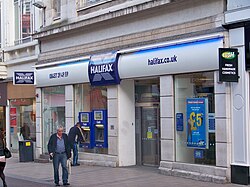Bank

A bank is a financial institution where customers can save or borrow money. Banks also invest money to build up their reserve of money. What they do is regulated by laws. Those laws differ in different countries. The people who work at a bank are called bank employees. Certain banks deal directly with the public and are the only ones that a regular person will work with. Other banks deal with investments and international currency trading.
The customer's money may be placed in the bank for safekeeping. Banks may give loans to customers under an agreement to pay the money back to the bank at a later time, with interest. An example is getting a mortgage to buy a house or apartment. Banks also can use the money they have from deposit accounts to invest in businesses to make more money.
In most countries, the rules for banks are made by the government acting through laws. A central bank (such as the Bank of England) changes how much money is issued at a particular time. This is a factor in the economy of a country, and the government makes the big decisions. These "banks of issue" take in, and issue out, coins and banknotes.
History
The word bank comes from the Italian word banco, meaning a bench, since Italian merchants in the Renaissance made deals to borrow and lend money beside a bench. They placed the money on that bench.
Elementary financial records are known from the beginning of history.[1] Baked clay records were done before the invention of writing.[2]
In the 17th century, merchants started storing their gold with goldsmiths in London. The goldsmiths had their own vaults and charged a fee for storing the merchants' gold. The goldsmiths eventually started loaning money using the gold left to them and also paid interest on the gold.
The Bank of England began issuing banknotes in 1695. The oldest bank still in existence is Monte dei Paschi di Siena in Siena, Italy, which started in 1472.
Banking activities
A bank usually provides the following services:
Types of banks
- Community development bank: regulated banks that provide financial services and credit to under-served markets or populations.
- Land development bank: The special banks providing long-term loans are called land development banks, in the short, LDB. The history of LDB is quite old. The first LDB was started at Jhang in Punjab in 1920. The main objective of the LDBs is to promote the development of land, agriculture and increase the agricultural production. The LDBs provide long-term finance to members directly through their branches.
- Credit union or Co-operative bank: not-for-profit cooperatives owned by the depositors and often offering rates more favorable than for-profit banks. Typically, membership is restricted to employees of a particular company, residents of a defined area, members of a certain union or religious organization, and their immediate families.
- Postal savings: savings banks associated with national postal systems.
- Offshore bank: banks located in jurisdictions with low taxation and regulation. Many offshore banks are essentially private banks.
- Savings bank: focuses on accepting savings deposits and paying interest on deposits.
- Building society and Landesbanks: institutions that conduct retail banking.
- A Direct or internet-only bank is a banking operation without any physical bank branches, conceived and implemented wholly with networked computers.
Bank Media
This 15th-century painting depicts money-dealers at a banca (bench) during the Cleansing of the Temple.
Interior of the Helsinki Branch of the Vyborg-Bank in the 1910s
Branch of Nepal Bank in Pokhara, Western Nepal.
Large door to an old bank vault.
A former building society, now a modern retail bank in Leeds, West Yorkshire.
An interior of a branch of National Westminster Bank on Castle Street, Liverpool
References
- ↑ Mesopotamia of 8000 BC.
- ↑ Davies G. & Bank J.H. 2002. A history of money: from ancient times to the present day. University of Wales Press.








